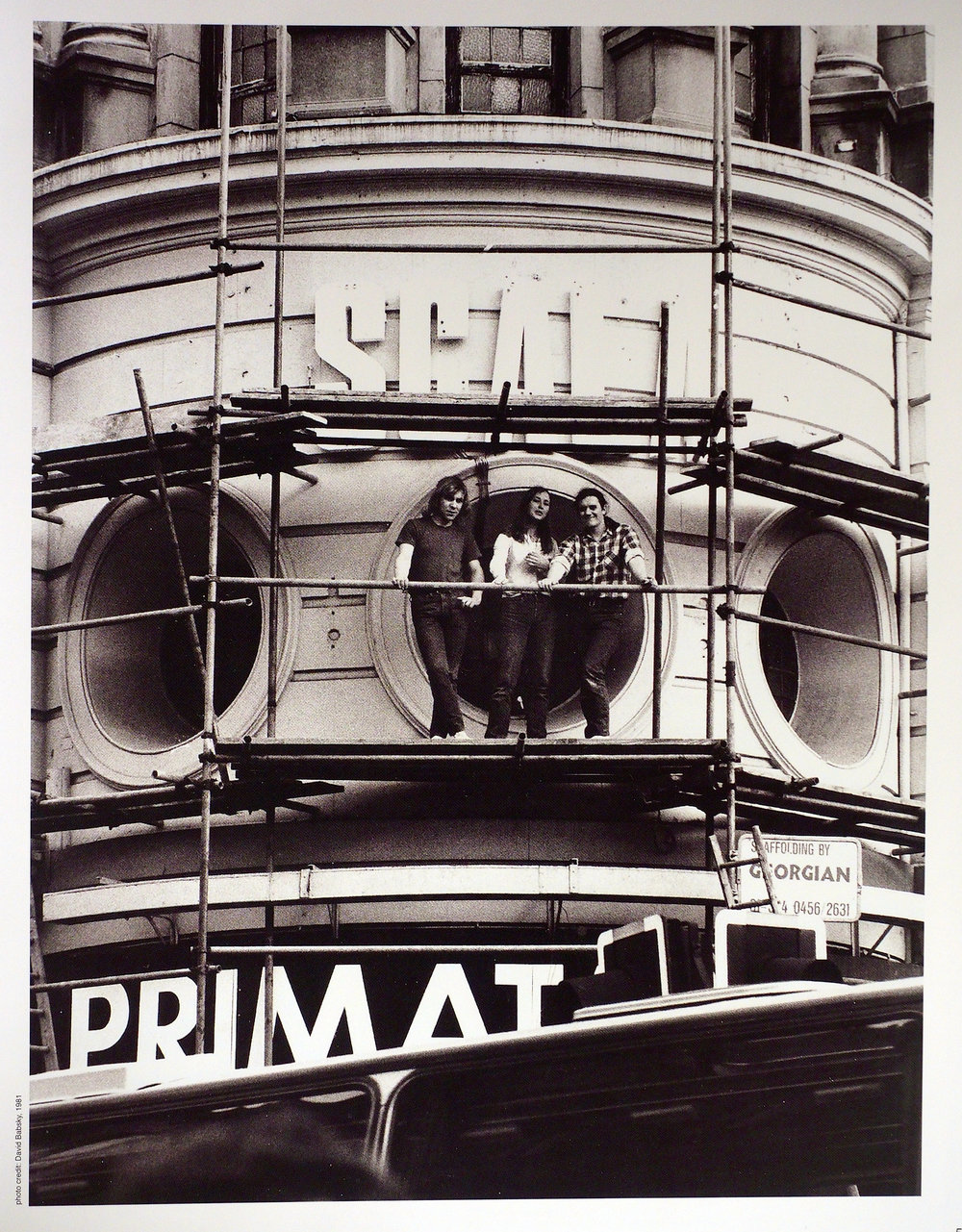
Back in 1981 — I nearly wrote 1891 — I would travel down to London, UK, from Peterborough where I worked, though you wouldn’t really call it work. I wrote about cameras and chemicals and lenses and photography in all its many ways for Practical Photography magazine, so I was paid money for fun, really, and I’d watch all the films I could swallow at the Scala cinema — first at Tottenham Street, just off the electronics mecca of Tottenham Court Road, and then at London’s King’s Cross, when the cinema moved to older premises once known as the King’s Cross Cinema.
I took some pictures on the opening night, when the Scala moved east from its previous Tottenham Street venue, and then I persuaded Steve Woolley, its progenitor, and Jayne Pilling, the cinema’s programmer, and Alan Gregory, the general manager, to step out onto the scaffolding at the front of the refurbished cinema to have their photo taken together, just beneath the massive newly-installed “Scala” sign.
I gave them a copy of that photo, and photos of the projectors being installed for the opening night . A couple of the pictures were printed in the next Scala programme sheet, and then I forgot about them.
They were ‘spur-of-the-moment” snaps; I just felt a need to document the re-establishment, the new home of this most marvellous of cinemas, which showed everything — between 1978 and 1993 — from 1920s black-and-white Marx Brothers to 1982’s Blade Runner, to John Waters’ 16mm ‘trash’ films Pink Flamingos and Mondo Trasho, Cinema Paradiso, Lawnmower Man and Eraserhead.
But just suddenly, that photo started appearing all over newspapers’ Arts and Culture pages last month, when Jane Giles’ HUGE (..and heavy: 5.5 kilograms..) history of the Scala Cinema 1978-1993 was published.
Besides having every programme of every film ever shown at the Scala appearing in its pages, Jane had gathered every photo ever taken of the cinema, and when she and Harvey, the book’s publisher at FAB Press, sent out press info about the book, every newspaper chose the same picture to head its feature; this one:
And it’s the first huge photo you see on the right-hand page when you open the book.
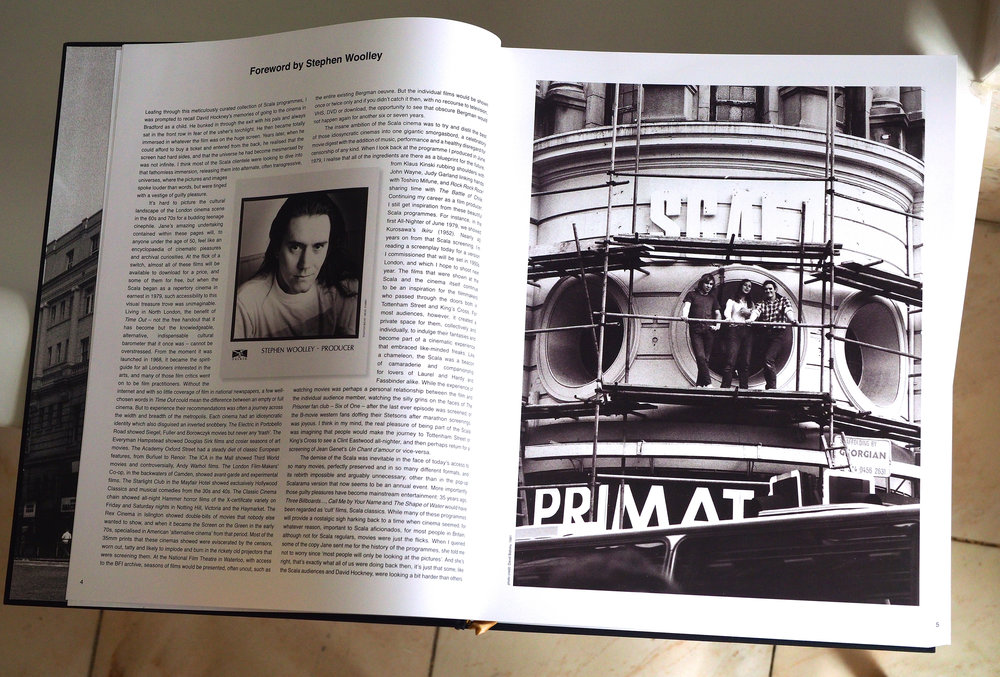
But why this photo?
Instead of just taking a picture of the three of them — Jayne, Stephen and Alan — I wanted to summarise the cinema’s move, and the re-generation of the Scala; to convey its resurrection, and not just as a record of people at its new premises.
So I insisted and inveigled that they went out onto the scaffolding (not easy, squeezing out through the only-half-opening window behind them) and then I ran across the road with my OM-2, a 100mm or 135mm lens and a few frames of Tri-X, and quickly took the shot before their enthusiasm wilted.
It’s a shot of people, and of purpose (….the scaffolding showing that work’s being done, to get the cinema up and running again..) and of identity (..that newly-installed sign).
That’s what newspaper photographers learn, or used to learn, when they began their working lives on the little local paper: you don’t want a photo of just a girl smiling, if it’s a local schoolgirl who’s won a place at Oxford (University); you want a wide shot of her grinning, surrounded by books, or you want her jumping for joy, or throwing her books in the air! You want to convey joy! ..success! ..achievement! ..and not just have a photo of some unremarkable face.
So the photo of those three people on the scaffolding conveys delight, resurgence, and identity.
Any mechanical, robotic camera, left to its own devices, can shoot a record of events. But a photo taken by a human can show not just a record of something, but what was in the mind of the photographer. A photo is a means to convey a photographer’s thoughts, an idea, a concept.
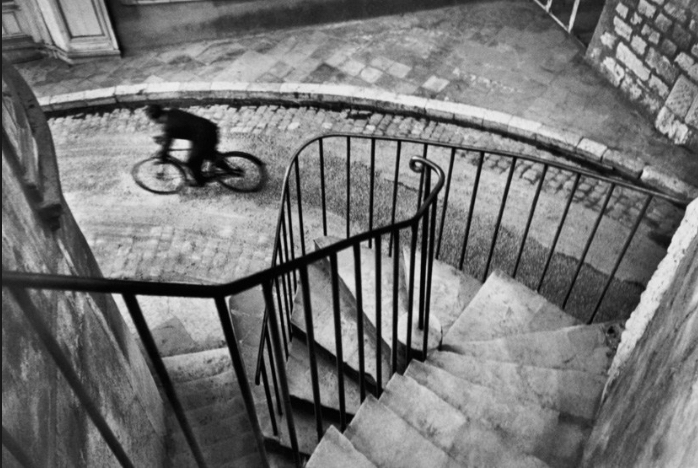
That famous photo by HC-B of a bicycle going round a bend conveys the idea of similar shapes repeated, and of activity. These three photos of hotels convey colour, shape, abstraction, as a space for humans to mingle in and rest. Of course, they wouldn’t look that great if they’d been taken with a ‘normal’ (50mm) lens: they’re shot with extreme wide-angles (14mm, or thereabouts) to each give a picture which you wouldn’t see with your everyday, commonplace human eyesight.
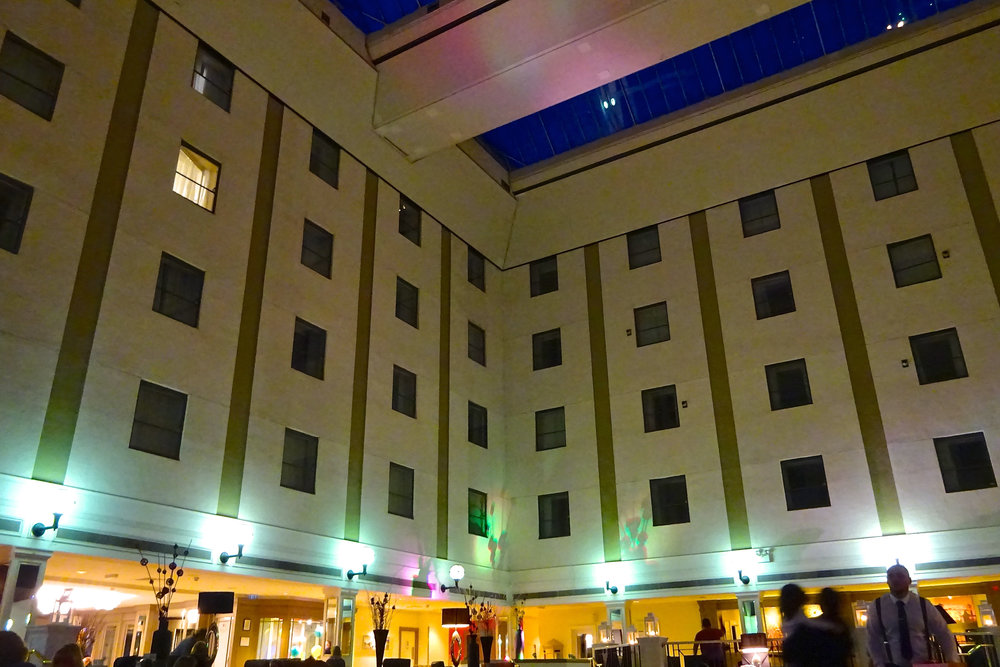
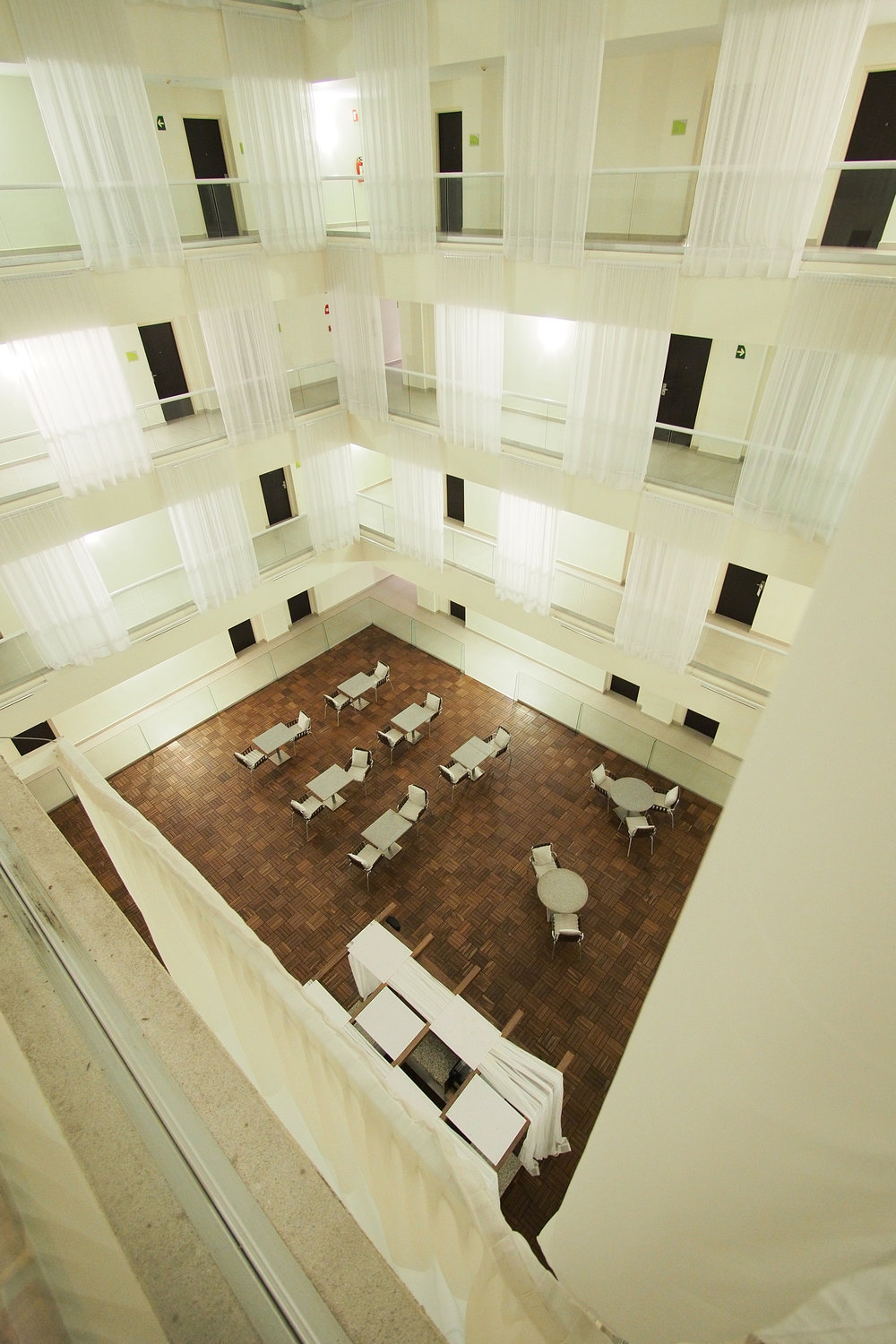
I’m not a believer in sticking with just one lens; to me that’s like writing ONLY WITH CAPITALS, or nly wth cnsnnts, or only prose
And never
ever
writing poetry.
Why deprive yourself of other angles, other viewpoints, other ways of seeing? (The picture of the three on the scaffolding would not have had much impact if they’d just been distant dots, taken with a ‘standard’ 50mm lens, and so I used a telephoto.)
When I teach, as I do, photography each year in Greece, once I’m sure that everyone knows how to physically manage their camera (..squeeze, let it focus, then squeeze the rest of the way when it’s in focus..) I give them six photos to take; not photos of things or people around them, but of ideas in their heads: Joy, Uncertainty, Imbalance, Scale ..and so forth.
“How do we take photos of ‘Uncertainty’?” “We-ell, it’s your camera; you decide!”
And so they go off, and they start to think.. “How do I express what I want to say?”
A camera’s like a pen ..hence, of course, the name Olympus PEN. You can keep it in your pocket, and then you can use it to express your thoughts so that other people can see your own thoughts!
A camera is not just for capturing a record of something, or for showing “this is how it was”. It’s an instrument for saying “Look at my thoughts!”
All images, except otherwise marked, copyright David Babsky

Thanks for this article, it brought back memories of the Scala for me; particularly the all night themed sessions watching a series of movies through the night fueled by beer, coffee and cushions with occasional walk-on parts by the local cat (as I remember) all followed by the odd feeling as you walk out into a early Sunday morning. Good times.
Great shot and story behind it, thanks again.
My pleasure, Nigel! (Jane describes the cats in her mammoth book; they were Huston – named after John – and Jane describes him as "..an extrovert tabby cat whose tail curled back to touch his shoulders. Huston always ran amok under the seats during the horror All-Nighters … and Roy the kitten hid in the lost property box.." ..and the third cat was Warren (..after Beatty, I think, but could have been Warren Oates).
Great times, huh? I remember the gents’ running with vomit during the all-nighters at Tottenham Street before the move to King’s Cross. Wonderful!
Lovely image of the Scala – a venue I frequented often for gigs and films. Thank you for the article. And William, my best Terry is second on the right in the Don McCullin ‘Guvnors of the Seven Sisters Road’ photo.
Although the Scala’s now a music venue, no longer a cinema, it was hired for the book’s launch party on 26th September; what a night! ..You should’a been there (..if you weren’t!..) ..the tears flowed like ..well, like Carlsberg Special!.. (wasn’t that what they drank in “Ice Cold In Alex”?)
What a wonderful image, and story to explain not only how it came to be, but also what it has come to be in the years that have passed.
I am also pleased to see you recommending the work of Matt Stuart in the comments below, I have looked at his street images, and watched a few youtube articles about his work. He is an exceptional photographer.
My view on improving what I catch is to go out and try – usually I get it wrong, and then try again. After all trial and error is part of how we improve our technique and understanding of the craft. And if you are like me, half the fun of going out with my camera is that I may not just capture a new image, or something uniques, but also that I could learn something new about my chosen art.
Cheers
Dave S
A thoughtful article David, on a range of levels. Thank you.
You’re welcome ..my pleasure, Wayne.
Thanks David,
I found your comments about communicating our thoughts fascinating. Have you written anything more on this, or considered doing so? Or can you recommend texts?
Kevin
Hi, Kevin,
“..Have you written anything more on this..” ..no, just what you see on this page.
I do write a four-page “crib sheet” for the people who come on my course, but that’s just mainly a reminder about what different apertures do, and when to use over-and under-exposure (..under-exposure for sunsets, for example..) and when to change the White Balance to “lightbulb” (or ‘Tungsten’) – in those ten minutes when the sun has completely set, and the sky’s gone quite black, for very deep blue skies, even though the sky looks utterly black to human eyes.
“..can you recommend texts?..” Er, no: texts, or reading, is for people who are studying words. If you’re keen on photography, look at pictures.
Look at this photo by Matt Stuart, for example ..I think this is the most beautiful photograph in the world:
http://www.mattstuart.com/qebxkjxrkgaakzkdi5s0ub7l04w5rr
..because it encapsulates all that there is about being human: about seeing beauty; about seeing not just a leaf, but something intangible ..as if the Cheshire Cat has just left the room ..I bought my Beloved his book “All That Life Can Afford:
http://www.mattstuart.com/book/
..because it contains a big print of that photo. Although the book’s sold out through his own website, I’m sure that you can find it online ..from Amazon, for instance.. or just browse through the other pics on his site ..though none is as beautiful as that simple leaf.
It isn’t really a photo of a leaf; it just uses the leaf to provide a picture of something completely intangible ..and that’s what I send out my students to take photos of.
Instead of reading some text, just give yourself six “intangible” subjects – not ‘themes’ like ‘clouds’, ‘trees’, ‘crowds’, etc, but ideas which are NOT physical objects – such as “hunger”, “satisfaction”, “imperfection”, etcetera, and then give yourself half an hour to take ONE single picture of each of those intangible ideas, so that you have just six photos, each of which is the result of some really concentrated thought.
(“How do I take a picture of ‘hunger’?” ..er, empty dog’s bowl? ..small plant unable to get light because a taller leaf obstructs the sun? ..empty cereal box?)
Once you start taking pictures of, for example, Joy, then if a friend asks you to shoot some wedding photos, instead of the results being just a catalogue of people at an event (..and somebody looking at the pictures saying “who’s that?”..) each one will be suffused with the joyousness of the event, so that someone looking at the photos says “Wow! She looks happy!” instead of just “Who’s that?”
So don’t look for “texts” ..look at pictures, and think “why did the photographer choose to shoot that then, and from there?” ..and “what does this picture convey?”
Hi David,
I want to thank you for your considered reply which I found most helpful. I’ll certainly look up the references.
Much appreciated!
All the best,
Kevin
You’re welcome!
Lovely photos David. For some reason the top photo reminds me of the famous Don McCullin ‘Guvnors of the Seven Sisters Road’ photo which started his career when it appeared in the Observer in 1959. I know that the two photos are different, but something in your shot reminded me immediately of McCullin’s.
As for changing lenses, I often bring 2 or 3 lenses in my bag, but 90% of the time I stay with the lens that I started out with. I am not sure whether this is laziness on my part or a determination to show that I made the right choice in the first place.
William
‘Guvnors of the Seven Sisters Road’ ..really? Well, he – later – used the same camera, and probably used the same film ..though that shouldn’t have any real effect on the results!
Perhaps it’s something to do with the confidence of the two men, in the ‘Scala’ picture, who are leaning on the scaffolding.
Congratulations on your photographic past coming into the present in a weighty presentation! An imaginative photo and a marvellous story. I thoroughly enjoyed your way of conveying the limits of one style and preferring the variety of poetry – shown beautifully in those three colour shots. I’m not a great lens-changer, but I do go in for different lenses on different cameras, which is my way of doing different styles. I think your conclusion is quite close to what I mean by "expressionist" rather than "impressionist" photography. (See my essay "Rising Eighty", macfilos 3.8.18.)
John N.
Seen it. Thank you, John.
Well said! Thank you for this article
My pleasure, John.